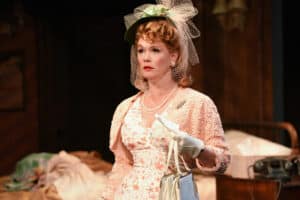Fever Dream: Streetcar at Everyman
Posted on BroadwayWorld.com April 18, 2016
Tennessee Williams‘ A Streetcar Named Desire is atmospheric, outsized, swampy, passionate, quirky, in short Southern Gothic. In most respects, Streetcar is therefore the polar opposite of Death of a Salesman, the play with which it is being paired and presented in rotating repertory by Baltimore’s Everyman Theatre. We know that Streetcar, unlike Salesman, does not pretend to hold a mirror up to reality, or to address social issues except incidentally. Streetcar is a drama of private dilemmas and passions. Streetcar has nothing in common with a tract and everything in common with a fever dream.
Director Derek Goldman understands this, and doubles down on the fantastic elements, injecting a “Vocalist” (Kelli Blackwell, often seen at Toby’s Dinner Theatre), who roams the set and sings mostly jazz and American Songbook standards that annotate the action, and makes of the somewhat already spectral street chorus (vendors, sailors and such) an even more sinister group that might have been drawn by Edvard Munch, especially the Mexican woman selling flores para los muertos, who is rendered in ghostly whiteface. He even imports the spectral Uncle Ben from Salesman (Carl Schurr) for a brief wordless appearance.
Equally wisely, Goldman presents but does not moralize upon the strange norms in the world author Williams presents, one in which spousal abuse is simply part of the rhythm of life to be accepted with patience, and rape may perhaps be understood as an over-effusion of animal spirits, while the discovery that one’s spouse is homosexual is cause for nervous collapse.
Goldman and his cast also try gamely to navigate the split personalities with which Williams has furnished two of his three principal characters. Stanley Kowalski (Danny Gavigan) is constantly described as an animal, but (except during the “Stella! Stella!” scene) he is not written that way: based on his lines he seems articulate and calculating, and he correctly demurs to the notion that as a Pole he must be stupid or somehow offensive. Blanche DuBois (Beth Hylton, pictured above) is a running fountain of misinformation, but from the script it is hard to tell how much of it she believes and how much she is taken in by her own lies. She is neither a hardened schemer nor a naif. Gavigan is given the harder task; the way he resolves his dilemma is to ignore almost all of the animality with which Williams supposedly endowed the character, and present us with a Stanley who is not likeable but is plenty human and probably the smartest character on the stage. More Marlon Brando might have been enjoyable, but this is a reasonable response to the hopeless task the script sets. Hylton’s path is clearer, and she takes it effectively: this Blanche’s belief in her self-generated legend is held in abeyance until close to the end. The moment when she transmutes the doctor come to hospitalize her (also Carl Schurr) into some kind of beau is the first time that she herself seems truly disoriented as to the line between fact and fantasy.
The Munch-like passers-by and the two not-quite-human principals aside, Williams has rounded out his dramatis personae with what for Williams pass as normal types, including the third principal Stella, Blanche’s sister (Megan Anderson), who brings a welcome toughness to a role that in other hands might seem more like a doormat. The message seems to be that it takes a strong woman to look the other way and/or forgive the well-nigh unforgivable. This may not be politically correct in contemporary terms, but it is almost certainly the way the mid-20th Century Williams thought. Goldman and Anderson’s unflinching accuracy on this point is appreciated. Chris Genebach, Dawn Ursula, and Bruce Randolph Nelson all bring care to various roles of ordinary folk as Williams in his strange way conceived them. In particular Genebach’s Mitch, a Williams archetype, the gentleman caller whose romantic attentions might solve the otherwise intractable problems of a lady in distress, but whose attentions are interrupted, is a solid portrayal.
It is clear that in this “Great American Rep” pairing of Streetcar and Salesman, Artistic Director Vincent M. Lancisi and the Everyman company want us to compare and contrast. Lancisi writes in the program:
Miller and Williams were revolutionary voices in the theatre world, literally changing the form of plays that were produced on stage from melodrama to realism with stories embodying both realistic and poetic dialogue never heard on our stages before. Common themes arise like the pursuit of the ever elusive American Dream and self perception versus reality.
Let’s unpack this.
Every true original playwright is revolutionary in an important sense, but few change the form. Miller and Williams were true originals, but Miller’s was hardly the only voice of his era exploring political and social themes. What was going on then was much larger than Miller himself. (To suggest otherwise ignores Hellman and Chayefsky and Odets, for instance, none of whom owed a perceptible debt to Miller, so far as I know.) Williams was so sui generis, so deep into half-closeted gay Southern Gothic, that he lacked peers or followers. He had the fortune or misfortune to come of age a mere half-generation before the explicitly gay theater established itself. And Carson McCullers was Southern Gothic all on her own.
Melodrama to realism? Well, no question that Miller was realistic, but it’s hardly fair to say he was revolutionary in that. The theater before Miller was not all Eugene O’Neill; there had been Strindberg and Ibsen, to pull two names out of the hat almost at random. And Williams was firmly melodramatic from first to last; he never showed any interest in realism.
Realistic and poetic dialogue of sorts never heard on our stages before? That may well be true, though I would again mention O’Neill in the same breath as these playwrights for such accomplishments.
American Dream? Well, yes, although as I pointed out in last week’s comments on the Salesman production, it is hard to decipher exactly what Miller is trying to tell us about the American Dream in that play, at least as Willy Loman’s failures relate to it. It is doubtless true that Blanche is a dreamer of sorts, but her dream is far different from Willy Loman’s. Hers is in the past, not the future. It is not by chance that the family estate she lost prior to surfacing in New Orleans was called Belle Reve (beautiful dream). It is a dream of bygone gentility, of a husband who (unlike her actual one) was capable of loving her as she loved him, of financial security and girlish good looks. And as I pointed out last week, while Willy cannot realize the Dream for himself, he can and does make it happen for his family, so it cannot even be called totally elusive for him, whereas it is obviously foredoomed as to Blanche.
Still, I believe that Lancisi in selecting these plays is onto something important. Miller and Williams are each important, classic American playwrights it’s always good to revisit. More crucially, we care about Willy and about Blanche in much the same way. Each is so passionately devoted to his or her version of the Dream that each continually feels licensed to lie to others and finally to himself/herself in the pursuit of that devotion, to the point where each character’s grip on reality slips and fails. We in the audience are continually torn between cheering the gumption and the desire behind the lies and being appalled at the human cost the lies inflict, not least on the tellers of them. But there is a difference; Willy comes to a moment of total clarity before the end that determines his final successful actions. Blanche’s moment at the end does achieve a success of sorts for her; she leaves the intolerable environment that her sister’s apartment has become, and we can assume she will be cared for at the state mental hospital to which she is headed. But she accepts the necessary relocation at the cost of vanishing into her delusive dreams.
If only for the opportunity to compare these two different dreamers, Lancisi and company deserve our gratitude. I hope that Everyman will repeat this experiment again in the future.
Copyright (c) Jack L. B. Gohn, except for production photo. Photo Credit: ClintonB Photography.


 I lived in London and Vienna before coming to the United States, and grew up mainly in Ann Arbor. I was writing plays and stories as early as grade school. My undergraduate years at the University of Pennsylvania, where I first reviewed theater, for the college paper, were succeeded by graduate study at the Johns Hopkins University, where I earned a doctorate in English Literature.
I lived in London and Vienna before coming to the United States, and grew up mainly in Ann Arbor. I was writing plays and stories as early as grade school. My undergraduate years at the University of Pennsylvania, where I first reviewed theater, for the college paper, were succeeded by graduate study at the Johns Hopkins University, where I earned a doctorate in English Literature.